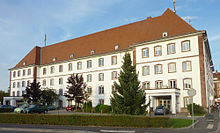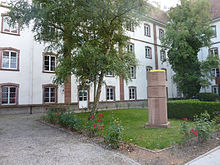Imperial Palace Hagenau
The Kaiserpfalz von Hagenau (French: Palais or Château impérial de Haguenau ) was a royal palace built under Emperor Friedrich I. Barbarossa in the Alsatian city of Hagenau . It was on an island surrounded by the mold in the old town in the area of today's Rue du Château (Schlossstrasse). Except for a few sculpture fragments in the Musée historique de Haguenau , no structural remains have been preserved. A Jesuit college was built on the site of the Palatinate between 1729 and 1739 and is now used as a maison de retraite (old people's home).
history
At the beginning of the 12th century, Duke Friedrich II of Swabia (called the one-eyed man ) had a moated castle built, which his son Friedrich I Barbarossa expanded into an imperial palace. With eighty stays, it was by far the most frequently visited Palatinate of the Staufer period by German emperors and kings. Barbarossa was nine times in Hagenau between 1153 and 1189, Heinrich VI. eight times, judging Richard the Lionheart in 1193. Philipp von Schwaben , Otto IV. , Friedrich II. , Heinrich (VII.) And Konrad IV. Were also there. The imperial regalia were probably kept in the Palatinate from 1153 to 1208, when they reached Trifels Castle. After the end of the Staufer period, the Palatinate lost its importance. From 1280 until the 17th century it was the official seat of the governor of Alsace. With the pillage of Hagenau by Marshal von Créqui in 1678, the Palatinate was also destroyed. In 1687 it was demolished in order to use the stones as building material for the Vaubansche border fortress Fort-Louis , built twenty-five kilometers east of Hagenau on the Rhine .
In the courtyard of the Maison de Retraite , a Staufer stele has been standing in memory of the Palatinate since 2012 (originally since 2006 in the Rue de la Moder ). There is also a plaque on the building with the inscription "RUE du CHATEAU - ANCIEN CHÂTEAU IMPÉRIAL - ICI S'ELEVAIT LA CHAPELLE PALATINE - BERCEAU DE LA VILLE DE HAGUENAU - CONSACREE PAR ST LEON IX VERS 1035 - GRANDIE PAR FREDERIC BARBEROUSSE VERS 1170 - 1184 - DEMOLIE EN 1687 "attached.
Palatine Chapel
The best-studied building in the Palatinate is the Romanesque chapel. Based on historical views and excavation findings, a fairly clear appearance could be reconstructed. Like most palatine chapels, it had two storeys, actually three as a structure. It was three-bay , had two small aisles, two apses and an octagonal tower. The treasury was on the third floor and was used to store the imperial regalia. The octagonal cross-section of the tower was based on the model of the Aachen Palatinate Chapel , especially since there is an octagonal chapel from the 11th century in Ottmarsheim in Alsace, directly based on Aachen, and with Eguisheim , Guebwiller and Wangen there are still three octagonal Stauferburgen. The ground plan and elevation reconstructed by Thomas Biller is more reminiscent of Byzantine sacred buildings ; There are also striking similarities with the double church of St. Maria and Clemens in Schwarzrheindorf . The Hagenau Chapel is dated around 1180. A few architectural fragments such as sculptures and arched friezes, which are closely related to the architectural sculpture of the Worms Cathedral , are in the Hagenau Historical Museum .
literature
- Thomas Biller, Bernhard Metz: The castles of Alsace - architecture and history. Volume 1: The beginnings of castle building in Alsace (until 1200) . Published by the Alemannic Institute Freiburg i. Br., Deutscher Kunstverlag, Munich / Berlin 2018, ISBN 978-3-422-07439-2 , pp. 303-313.
- Fritz Bouchholtz: Castles and palaces in Alsace. Frankfurt am Main 1962.
- Nicolas Mengus, Jean-Michel Rudrauf: Châteaux forts et fortifications médiévales d′Alsace. Dictionnaire d′histoire et d′architecture . La Nuée Bleue, Strasbourg 2013, ISBN 978-2-7165-0828-5 , pp. 126–128.
- Charles-Laurent Salch: Dictionnaire des châteaux de l'alsace médiévale. Strasbourg 1976.
Web links
- Peter Koblank: The missing royal palace of Haguenau on stauferstelen.net.
- Thomas Biller: The Palatine Chapel in Hagenau - New considerations on its reconstruction on archiv.ub.uni-heidelberg.de. Original publication in: Chateau forts d'Alsace, 10 (2009), pp. 19-34.
Individual evidence
- ↑ In German: "Schlossstrasse - Altes Kaiserschloss - the Palatine Chapel - cradle of the city of Hagenau - consecrated by St. Leon IX around 1035 - enlarged by Friedrich Barbarossa around 1170 to 1184 - destroyed 1687"
Coordinates: 48 ° 48 ′ 56.9 ″ N , 7 ° 47 ′ 18.3 ″ E



